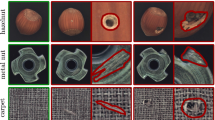Abstract
In this paper we explore the utility of compressive sensing for object signature generation in the optical domain. In the data acquisition stage we use laser scanning to obtain a small (sub-Nyquist) number of points of an object’s boundary. This is used to construct the signature, thereby enabling object identification, reconstruction, and, image data compression. We refer to this framework as compressive scanning of objects’ signatures. The main contributions of the paper are the following: (1) we use this framework to replace parts of the digital processing with optical processing and present one possible implementation, (2) the use of compressive scanning reduces laser data obtained and maintains high reconstruction accuracy, and (3) we show that using compressive sensing can lead to a reduction in the amount of stored data without significantly affecting the utility of this data for image recognition and image compression.








Similar content being viewed by others
References
Arkin EM, Chiang YJ, Held M, Mitchell JSB, Sacristan V, Skiena SS, Yang TC (1998) On minimum-area hulls. Algorithmica 21(1):119–136. doi:10.1007/PL00009204
Baggs R, Tamir DE (2008) Image registration using dynamic space warping. In: Artificial intelligence and pattern recognition’08. pp 128–135
Beck A, Teboulle M (2009) A fast iterative shrinkage-thresholding algorithm for linear inverse problems. SIAM J Imaging Sci 2(1):183–202
Candes E, Tao T (2006) Near-optimal signal recovery from random projections: universal encoding strategies. IEEE Trans Inf Theory 52(12):5406–5425
Candes E, Wakin M (2008) An introduction to compressive sampling. IEEE Signal Process Mag 25(2):21–30
Donoho D (2006) Compressed sensing. IEEE Trans Inf Theory 52(4):1289–1306
Elad M (2007) Optimized projections for compressed sensing. IEEE Trans Signal Process 55(12):5695–5702
Frueh C, Zakhor A (2003) Constructing 3d city models by merging ground-based and airborne views. In: Proceedings of the 2003 IEEE computer society conference on computer vision and pattern recognition, vol 2, II - 562–9
Gonzalez RC, Woods RE (2006) Digital image processing, 3rd edn. Prentice-Hall Inc, Upper Saddle River
Hug C (1997) Extracting artificial surface objects from airborne laser scanner data. Autom Extract Man-Made Objects Aerial Space Images II:203–212
Im YS, Choe JY, Oh TK, Paek EG, Tang X (2000) Experimental nonmechanical image rotation to 20 angles using an acousto-optic dove prism. Opt Eng 39(11):2909–2914
Keogh E, Wei L, Xi X, hee Lee S, Vlachos M (2006) Lb keogh supports exact indexing of shapes under rotation invariance with arbitrary representations and distance measures. In: IN VLDB, 2006. pp 882–893
Lustig M, Donoho DL, Santos JM, Pauly JM (2007) Compressed sensing MRI. EEE Signal Process Mag 25(2):72–82
Pavlidis T (1982) Algorithms for graphics and image processing. Digital system design series. Computer Science Press, Berlin
Porat B (1997) A course in digital signal processing. Wiley, New York
Rivenson Y, Stern A, Javidi B (2010) Compressive fresnel holography. J Disp Technol 6(10):506–509
Scafter K (2011) Laser diode collimator flatbeam. http://www.sukhamburg.com/onTEAM/pdf/cam_cat_44-45_en.pdf
Swift D (1972) Image rotation devices—a comparative survey. Opt Laser Technol 4:175–188
Tamir DE, Shaked NT, Geerts WJ, Dolev S (2011) Compressive sensing of object-signature. In: Dolev S, Oltean M (eds) Optical superComputing. Lecture Notes in Computer Science, vol 6748. Springer, Berlin Heidelberg, pp 63–77
Tamir JI, Tamir DE, Dolev S (2012) Object signature acquisition through compressive scanning. OSC-2012, Bertinoro, Italy
Xiong J, Schlottau F, Li Y, Wagner K (2004) Nonmechanical programmable image rotator with Glan-Thompson prism. Proc SPIE 5557:124–131. doi:10.1117/12.557988
Ye JC (2007) Compressed sensing shape estimation of star-shaped objects in fourier imaging. IEEE Signal Process Lett 14(10):750–753
Author information
Authors and Affiliations
Corresponding author
Rights and permissions
About this article
Cite this article
Tamir, J.I., Tamir, D.E., Geerts, W.J. et al. Compressive scanning of an object signature. Nat Comput 14, 457–467 (2015). https://doi.org/10.1007/s11047-014-9460-7
Published:
Issue Date:
DOI: https://doi.org/10.1007/s11047-014-9460-7




